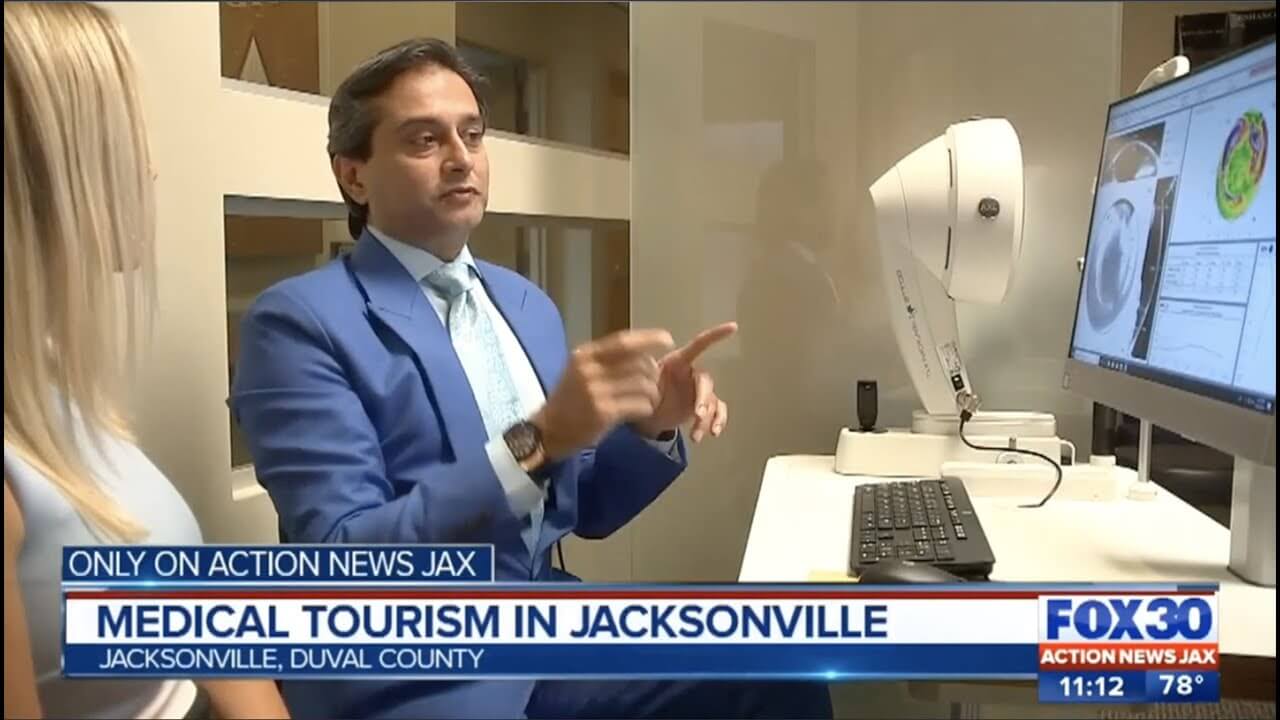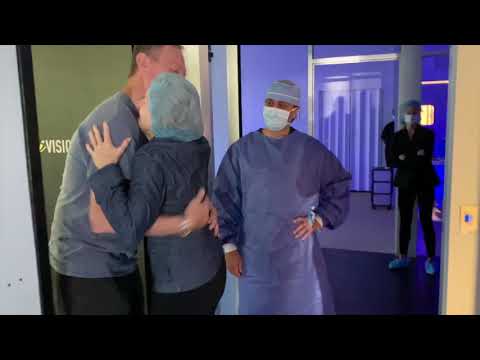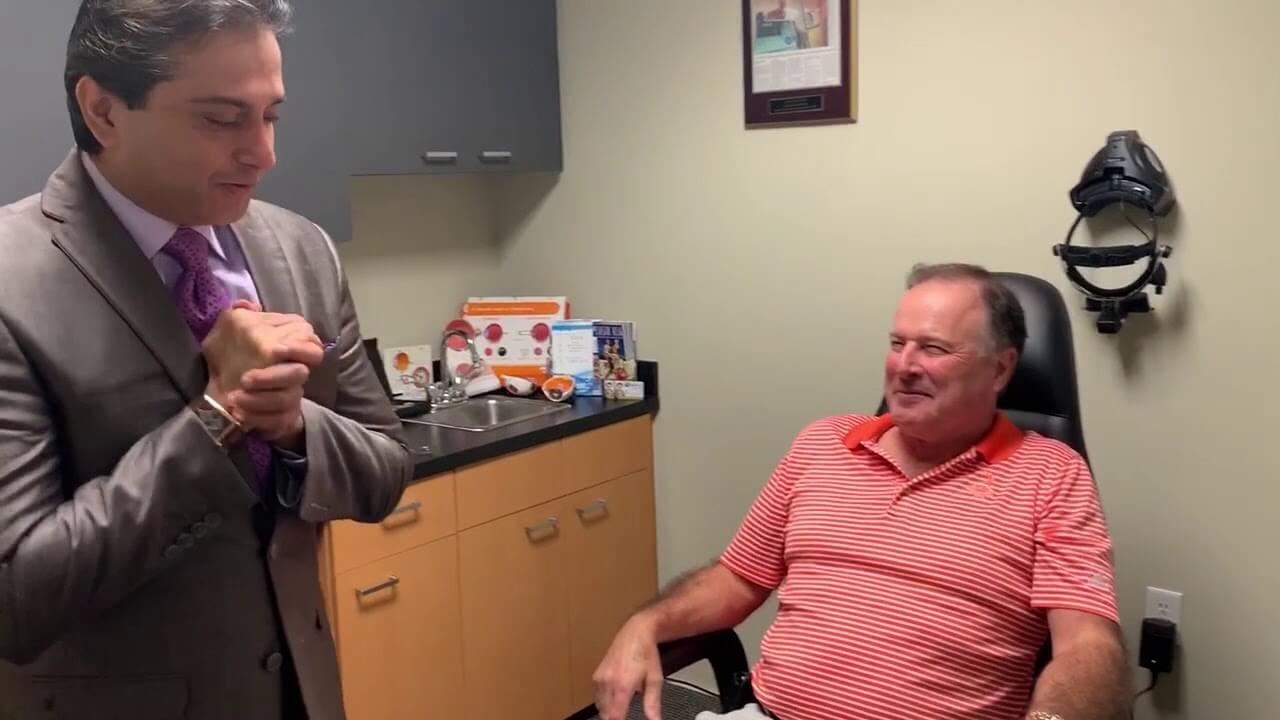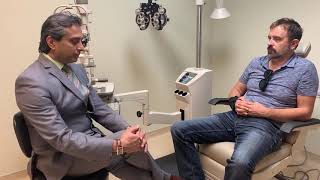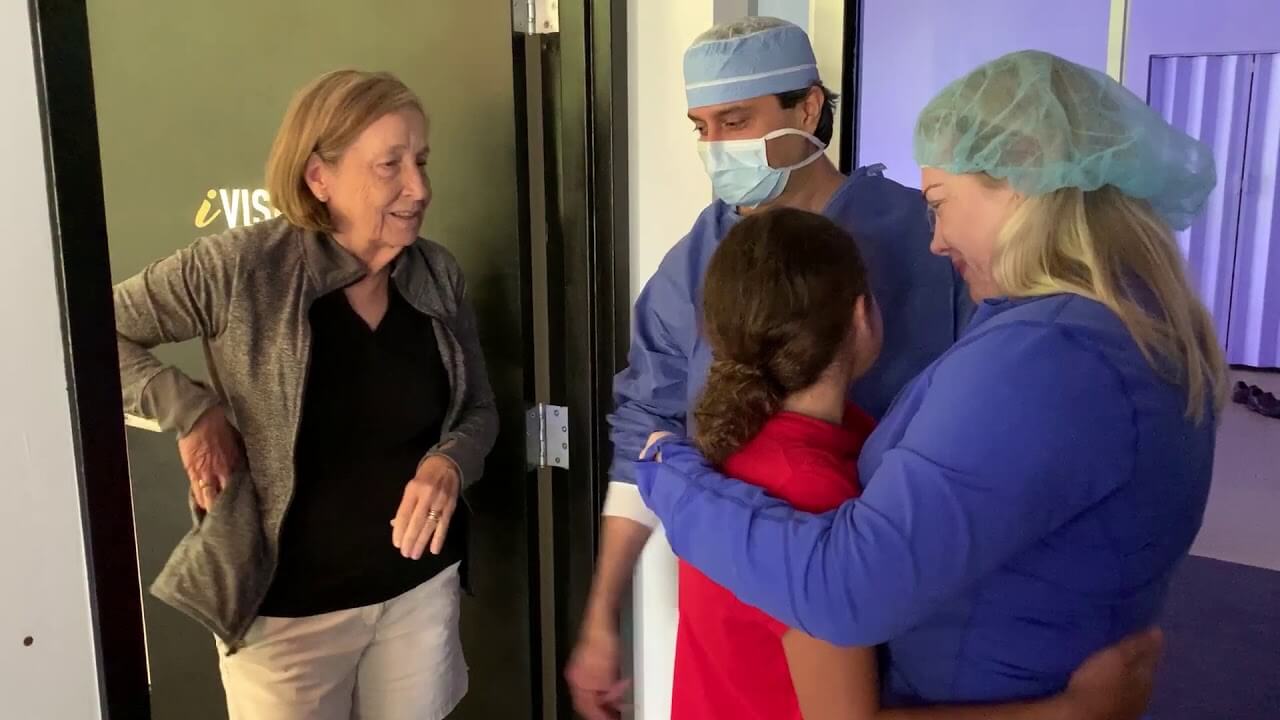Refractive Lens Exchange (RLE)
Refractive lens exchange (RLE), also called lens replacement surgery or clear lens extraction (CLE), is an elective refractive surgery procedure in which the natural crystalline lens of the eye is removed and replaced permanently with an artificial lens implant to correct the refractive error (Nearsightedness, Farsightedness and or Astigmatism) along with Presbyopia (reading glasses) improvement. RLE surgery is similar to cataract surgery; however, in RLE, the procedure is performed primarily to change the refractive properties of the eye rather than to remove a cataract that has developed in the lens of the eye.

Dr. Gulani’s CLOUDY (Crystalline Lens Opacification Underway) concept:
As we age, our eyes undergo visual changes to result in poor vision, both, in quality and quantity. Think of our natural crystalline lens as being jelly-soft and clear as a diamond. Over time, it gets cloudy and hard. This stage is still not defined as cataract until it is of a certain level of opacity and blindness quotient impacting the patient’s lifestyle adversely.
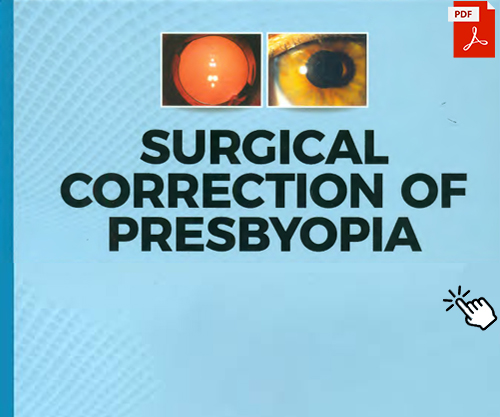
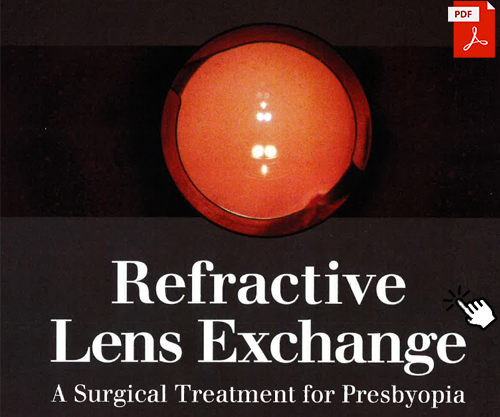
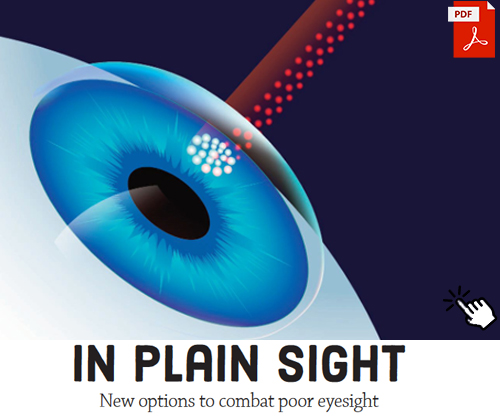
Defined as Dysfunctional Lens Syndrome (DLS), this is the stage of life when people in their prime of personal and professional life experience diminished visual quality, difficulty driving at night and reading menus in dim lit restaurants.
Additionally, by the time this occurs we are surely over 40 years of age and that is when our lens also stops zooming in the eye (that is why people zoom with their hands and hold things far to read clearly). This condition is called Presbyopia (that age and stage when you need reading glasses).
Now, if you put these two problems together, you have a combination of pre-existing glasses/contact lens powers (like nearsighted, farsighted, astigmatism) and presbyopia and somewhat unclear natural lens.
Let me interrupt for a correlate here. This lens if cloudier for any reason is defined as a CATARACT.
I could go deeper into the nuances of how I decide on what surgery to perform but simply put, I now look at all refractive errors, level of lens cloudiness and presbyopia and age and make a decisions between 20 different laser Vision techniques (like LASIK) and a more permanent and long term surgery (though more interventional) like RLE.
My Laser techniques are done with permanence in mind but this surgery is more so because we are removing the only changing optical element here (our natural lens).
Now think of this as never having a Cataract in the future.
How Does RLE Work?
In hyperopic (farsighted) or myopic (nearsighted) patients, the light coming into the eye is not focused properly on the retina. This poor focus may be due to the eye’s crystalline lens either being too weak or too strong to help focus light appropriately. By removing the eye’s crystalline lens and replacing it with an artificial lens the light is able to focus better on the retina and therefore reduces the person’s dependence on glasses and contact lenses. The artificial lens that is placed in the eye, called an intraocular lens (IOL), can be chosen depending on the refractive needs of the patient’s eye.
The procedure for refractive lens exchange is therefore similar anatomically though refractively more demanding than cataract surgery. The difference is that in RLE, the lens being replaced is clear or slightly cloudy, rather than a cloudy, visually disabling lens due to a cataract. As in cataract surgery, many types of IOLs are available to replace your natural lens, depending on your anatomy, physiology, optical status and health of your eyes.
Dr.Gulani is always among the first in the world with his international privileges and has access to lens implant (IOL) technologies without decision wavering by industry marketing or incentives of any kind.
While most surgeons may offer 3 or 4 options, while Dr. Gulani has access to a wide variety of lens implants among nearly 30 that are US FDA approved in the USA and nearly 70 worldwide.
Rather than confuse patients with lens implant technologies, Dr.Gulani focuses on vision and the brain’s ability in each patient to fuse binocular vision for maximal freedom at most distances.
Some examples of lens implants are:
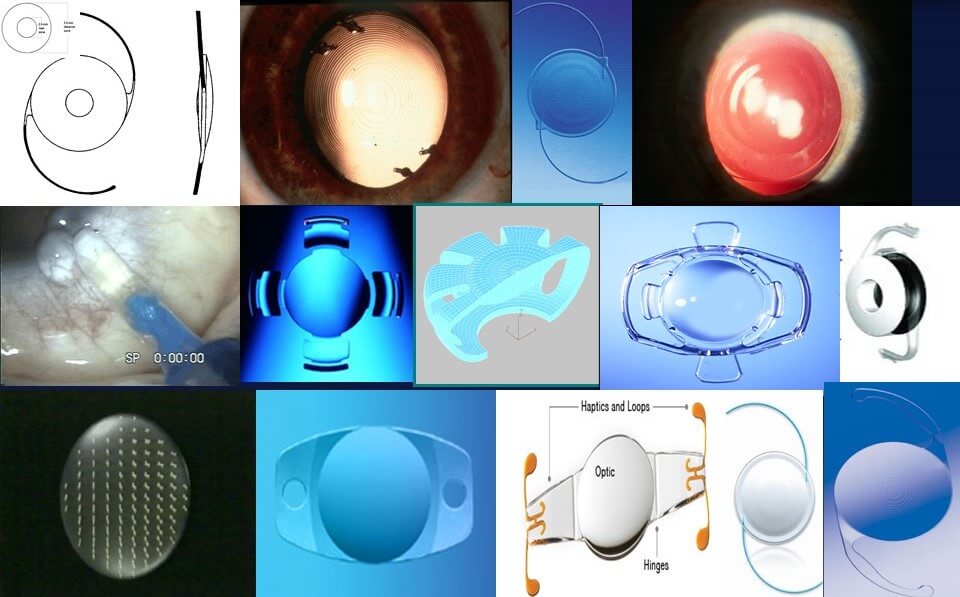
- Monofocal IOL
- Toric IOL
- Trifocal IOL
- Multifocal IOLs
- Accommodating IOLs
- Pseudo-Accomodative
- Adjustable IOLs
- PiggyBack IOL
- Phakic Implants
Additionally he has access to more than one optical platform in a single lens implant ie. Toric Monofocal, Toric Multifocal, Toric Trifocal etc.


Dr. Gulani has been involved with different lens implant technologies for over three decades having interacted with the very pioneers of these inventions which continue to evolve into present and future lens implant concepts.
Since with intraocular lenses, there is no “one size fits all,” your eye surgeon should recommend an IOL that is most suitable for your individual needs.
LenzOplastique as a Part of RLE:
LenzOplastique™ (the “O” stands for “Optimized Vision”): Raising Cataract and Refractive Lens Exchange Surgery to an ART, Dr. Gulani’s relentless pursuit to design vision and lend artistry to surgery raises even cataract surgery to his proprietary approach called LenzOplastique™ where he personally studies all patient diagnostics and measurements including anatomy, physiology, optics, and vision potential to diligently apply his vast array of lens based surgical technologies and techniques along with his “Vision A La Carte” concept to customize surgery in a holistic approach individually tailored to each eye no matter how simple or complex it is and also in combination surgical concepts.
Therefore, after studying your eye’s anatomy, physiology, optics and visual capacity in sync with your neural (Brain) potential becomes Dr. Gulani’s goal.
So what is the difference between RLE and LASIK?
They are totally different and on different parts of the eye. While LASIK remains the most popular option for correcting myopia and hyperopia, if you have a very severe refractive error or an abnormal cornea, lens-based refractive surgery such as clear lens extraction or phakic IOL implantation may be a better alternative.
Unlike LASIK or PRK, refractive lens exchange can correct almost any degree of hyperopia, and visual acuity after RLE surgery often is better than LASIK and PRK outcomes in cases of moderate and high hyperopia.
If you have myopia, RLE usually is performed only if you are not a suitable candidate for any other vision correction surgery. People with myopia have a higher risk of retinal detachment during clear lens extraction, and other refractive surgery options should be explored first.
Who are candidates for RLE?
RLE is most commonly used for middle age and older hyperopic (farsighted) patients that have higher levels of farsightedness than can effectively be treated with LASIK/ PRK/ LaZrPlastique and bearly 20 different cornea based Laser Vision techniques. These individuals are typically also presbyopic. Myopic and astigmatism patients can also avail of these under specific circumstances.
Additionally, some patients also have a mild degree of cataract; the cataract may not be causing symptoms currently, but will probably progress and cause vision problems in the future. In these patients, exchanging the natural crystalline lens of the eye for an artificial lens may help correct both the farsightedness, astigmatism and the presbyopia symptoms.
In general, candidates for RLE should be:
- 21 years of age or older: younger people may still have eyes that are growing.
- Want to decrease dependence on glasses or contact lenses.
- Have had no change in glasses or contact lens prescription for at least a year.
- Have otherwise healthy eyes.
- Be willing to accept the relative risk associated with surgery.
- Understand that glasses and/or contacts may still be needed for some activities after surgery.
If you feel you have any condition that may prevent you from undergoing RLE or other refractive surgeries, you should alert your eye surgeon so that he or she can help you make the best choice about undergoing refractive surgery.
Refractive Lens Exchange (RLE): The Procedure

Lens replacement surgery usually takes about 15 minutes and is performed on an outpatient basis. Each eye is done separately, usually about a week apart. Numbing anesthetic drops are used during RLE to decrease any discomfort.
At Gulani Vision Institute, RLE is done in our State of the Art Suite in a spa like atmosphere where you are welcomed without any rush and individually attended to so Dr.Gulani can personally apply his custom designed plan for your eye.
Most of our patients fly back home the next day after their postoperative visit but if you are local, do plan for rest for two days.
Final outcomes of refractive lens exchange can take up to several weeks, and you may notice vision disturbances such as blurry vision, halos and glare, or a “scratchy” sensation as your eyes heal. You should be able to return to work and resume driving within a week of surgery, dependent on your eye surgeon’s instructions.
Normally, you won’t feel an IOL in your eye, in the same way that you don’t feel a dental filling for a cavity.
The artificial intraocular lens is a permanent replacement for your natural lens and is designed to last the rest of your life.
Is 20/20 vision guaranteed with RLE?
Though Dr. Gulani’s results with this surgery are legend and the reason patients fly from all over the world, we do not guarantee outcomes.
RLE surgery is an extremely advanced technology for surgical vision correction. The excimer laser is one of the most precise instruments available for use in modern medicine, and it can be programmed to match the exact refractive correction your eye needs to see well. As such, the vast majority of people undergoing RLE surgery are very happy with their post-procedure vision. In fact, a person’s happiness with their vision after the procedure is a far more important measure of success than the somewhat arbitrary “20/20” measurement done in a dark room of a doctor’s office.
However, several factors may lead to a person still needing additional help from glasses or contact lenses post-surgery. Though very precise measurements and surgical technique are used for RLE surgery, the physical execution of safe surgery itself is a goal to then be followed by the individual healing response of each patient which may result in some variability of the final refractive outcome. The risks associated with RLE are higher than Lasik kind of surgery as this surgery is inside your eye. Most people however are highly satisfied with the surgery.
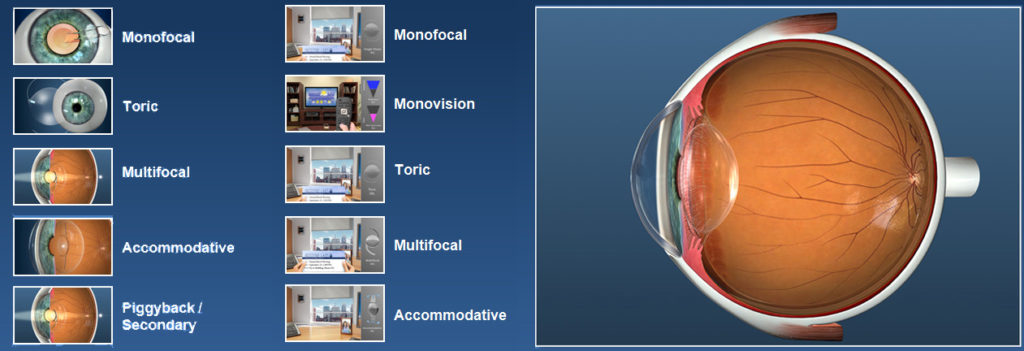
Technique
“No Needles”, “No Patch” & “No Stitch” Refractive Lens Exchange Surgery
Dr. Gulani performs refractive lens exchange surgery as an outpatient procedure with no needles or shots, no stitches, no patch and also, no hospital stay.
Every step has been planned out from how he sits for your surgery to what direction he will approach your eye from (sometimes, we have seen himself sitting uncomfortably to help patients who have very complex eyes and rarely we have even see him stand and operate).

The eye is numbed with drops to ensure comfort throughout the procedure. He uses sophisticated, computer programmed technology along with his invented Diamond instruments to customize the safe and accurate removal of your natural lens.
Its removal requires replacement with an artificial intra ocular lens implant (IOL) which is inserted through the microincision into the capsular bag of the natural lens for support. Once inside the eye, the lens spontaneously unfolds as it is placed into permanent position. No sutures are required because the small incision that Dr. Gulani designed is self-sealing.
Gulani Custom Refractive Lens Exchange surgery with Lens implantation usually takes about 15 minutes and is performed on an outpatient basis in our proprietary US PTO Trademarked, Surgical SPA. Each eye is done separately, usually about a week apart. Numbing anesthetic drops are used to decrease any discomfort.
Most of our patients fly back home the next day after their postoperative visit but if you are local, do plan for rest for two days and plan to resume work/driving within a week of surgery dependent on your individual case complexity which shall be relayed to you by our competent and compassionate staff.
Technology

Computer Programmed, Laser focused & Diamond specific
With a wide array of technology right from diagnostic to intra-surgical including computer directed and real time feedback enhanced ultrasound along with his personally invented Diamond instruments Dr. Gulani sets about to execute his custom designed plan raising technology at all levels driving for your best outcome keeping safety in mind. He therewith custom fits the technology to each patient rather than fit the patient to the surgery.
Target
After a detailed personal evaluation of your eye and all diagnostics along with having determined your best vision potential, Dr. Gulani teaches surgeons that there are two parts to refractive lens exchange surgery today; one is the surgery itself and second, is the pursuit of the custom-planned vision goal (Target) best suited for each individual patient. Thus, he believes that refractive lens exchange surgery should be an “Avenue” leading to that higher cause.

These Vision Targets could range from Mono Vision, Blend Vision, Multifocal or Pseudo-accommodative Vision to differentially arranging each eye’s optics so they work together to provide the best Vision range.
“It’s the Brain that sees, not your eyes.”– Gulani, AC
Given the individual healing pattern of each patient, Dr. Gulani likes to reiterate that no surgery or technology can guarantee vision without glasses but every effort can be made to aim for that goal though safe surgery is still a first prerequisite.


